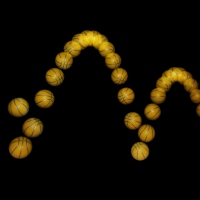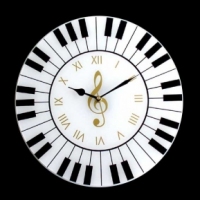Three-Beat Pattern
 Like I said in the previous post, I’m busy drawing beating patterns. I just finished the pattern with three counts in a bar, like the 3/4 and 3/8 time signatures.
Like I said in the previous post, I’m busy drawing beating patterns. I just finished the pattern with three counts in a bar, like the 3/4 and 3/8 time signatures.
Below is the three beat pattern that is legato. That is, the movement on all beating points is rounded, to create a flowing sound from the musicians:

 Whenever you are singing fast, energetic songs, the music will sound good if you make small accents on the notes. In this way you are emphasizing the rhythmical character of the music. We might call this ‘percussive’ singing. It is opposite to the classical way of legato singing.
Whenever you are singing fast, energetic songs, the music will sound good if you make small accents on the notes. In this way you are emphasizing the rhythmical character of the music. We might call this ‘percussive’ singing. It is opposite to the classical way of legato singing. In a previous post we talked about solfege. I argued that singing from sight can be best learned by giving numbers to the notes in the scale and relating all notes to the root.
In a previous post we talked about solfege. I argued that singing from sight can be best learned by giving numbers to the notes in the scale and relating all notes to the root. Rehearsing notes with a choir is not very enthralling. The director is singing the notes (or playing them on the piano) and the singers are repeating the notes. It may take a lot of time before all voice groups know their parts. Probably the director starts with the top part (because it often is the melody) and works his way down. By the time the basses have their turn, five or ten minutes may have passed.
Rehearsing notes with a choir is not very enthralling. The director is singing the notes (or playing them on the piano) and the singers are repeating the notes. It may take a lot of time before all voice groups know their parts. Probably the director starts with the top part (because it often is the melody) and works his way down. By the time the basses have their turn, five or ten minutes may have passed. For choral members it is useful to be able to sing from sight. A lot of singers hae the skills a bit. But most of the singers get stuck when the jumps get bigger than a third.
For choral members it is useful to be able to sing from sight. A lot of singers hae the skills a bit. But most of the singers get stuck when the jumps get bigger than a third. A lot of choirs always stand in the same way, lining up from highest to lowest voice. However, this is not the ideal formation. Other positions may be preferred for acoustic reasons or because they will make it easier for the singers to hear each other well.
A lot of choirs always stand in the same way, lining up from highest to lowest voice. However, this is not the ideal formation. Other positions may be preferred for acoustic reasons or because they will make it easier for the singers to hear each other well.
 In conducting, you are using the hands to indicate different kind of expressions. For a soft sound, the palms are turned downwards. And for a large sound, the palms are turned upward. For a tender sound, you keep your hand relaxed and for a powerful sound, you make the hand solid. If you want to ask for a precise timing, you put together your thumb and indicating finger. Each pose has a different meaning.
In conducting, you are using the hands to indicate different kind of expressions. For a soft sound, the palms are turned downwards. And for a large sound, the palms are turned upward. For a tender sound, you keep your hand relaxed and for a powerful sound, you make the hand solid. If you want to ask for a precise timing, you put together your thumb and indicating finger. Each pose has a different meaning. Though singing in a group is wonderful, choir members are often late for rehearsal. That’s the way it goes. Maybe it’s part of human nature. Somehow people tend to think being early is silly and being late is acceptable.
Though singing in a group is wonderful, choir members are often late for rehearsal. That’s the way it goes. Maybe it’s part of human nature. Somehow people tend to think being early is silly and being late is acceptable. Using a tuning fork to indicate chords is difficult. Do we really have to? A lot a directors are scared for it, because it involves a lot of steps. First you have to understand the chord, next search for the root, imagine the right notes and sing the notes with a good intonation while looking at the voice groups. Indeed, it isn’t easy! Nevertheless, we should learn it! On a concert, you should be reluctant to indicate the notes of an a cappella with the piano. It just won’t fit and you will look unprofessional as a conductor.
Using a tuning fork to indicate chords is difficult. Do we really have to? A lot a directors are scared for it, because it involves a lot of steps. First you have to understand the chord, next search for the root, imagine the right notes and sing the notes with a good intonation while looking at the voice groups. Indeed, it isn’t easy! Nevertheless, we should learn it! On a concert, you should be reluctant to indicate the notes of an a cappella with the piano. It just won’t fit and you will look unprofessional as a conductor.